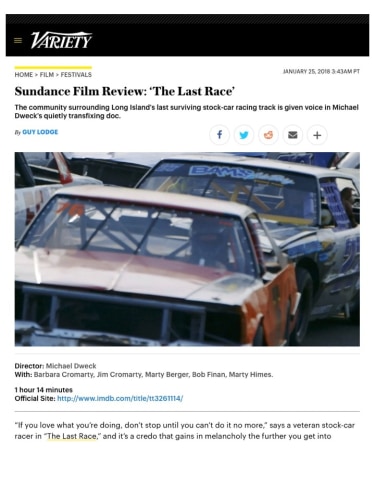Sundance Film Review: ‘The Last Race’
Variety
01/25/2018
Back
By Guy Lodge
The community surrounding Long Island's last surviving stock-car racing track is given voice in Michael Dweck's quietly transfixing doc.
Director: Michael Dweck
With: Barbara Cromarty, Jim Cromarty, Marty Berger, Bob Finan, Marty Himes.
1 hour 14 minutes
“If you love what you’re doing, don’t stop until you can’t do it no more,” says a veteran stock-car racer in “The Last Race,” and it’s a credo that gains in melancholy the further you get into Michael Dweck’s quietly plaintive documentary: It’s not so much age or physical weakening to which the man refers, as a dwindling subculture whose very space is under threat from capitalist spread. Tracking a season on and around Long Island’s modest, venerable Riverhead Raceway — watching the racing, bonding and brawling that shapes the weekends of its blue-collar community while consumer-minded real-estate developers eye up their valuable land — this graceful, ruminative fragment of scrap-metal Americana marks a distinguished foray into feature filmmaking for renowned narrative photographer Dweck. Docfest programmers will hit the gas, with streaming-oriented distribution likeliest to tail them.
The world of Riverhead racing, with its ramshackle hand-built vehicles, mom-and-pop management and homily familiar PA system, is a million miles removed from the souped-up, amped-up, slickly commercial stadiums of the NASCAR heartland. A series of opening title cards — the film’s one concession to informational documentary convention — informs viewers that Long Island, where stock car racing originated in 1927, was once home to over 40 tracks, of which Riverhead is the last survivor. Also mentioned is the nearby airstrip from which Charles Lindbergh made the first Transatlantic flight, which gave way to America’s first shopping mall in 1956.
At first, this last fact seems like something of a non-sequitur, but Dweck’s brisk, 74-minute film, which eschews narration for steady observation, nudges viewers to make the connection clearly enough. As the Raceway’s Barbara and Jim Cromarty, a married couple of retirement age, balance the books in their cluttered, wood-paneled office, the din of construction work seeps through the windows, as acre upon acre of neighboring woodland falls to a plethora of Costcos, Walmarts and all-purpose malls. The land on which the Raceway sits, worth $10 million, is squarely in developers’ sights, and after 40 years of managing it, Barbara and Jim don’t mind admitting they’re weary of the grind.
Outside, however, it’s petrol-scented business as usual for the quarter-mile track’s passionate coterie of amateur racers and onlookers, who gather weekly to shoot the breeze and crunch metal against metal as they take their lovingly modified speed machines out for a competitive spin — sportsmanship occasionally taking a breather as the more hot-headed drivers fight over perceived infractions. The winnings are meager and the trophies cheaply gilded, but the adrenaline rush of the race is where it’s at for participants. Dweck and editor Charlotte Munch Bengtsen cannily contrast the sweaty, twitchy communal track action with gentler passages of the drivers’ daily routines: As they wait for the weekend, the film’s agreeably chatty subjects (unnamed until the closing credits) fuss over their cars, tend to their tomato plants and labor in jobs that range from pest control to clam-digging.
These are not unhappy or unfortunate lives, and Dweck, whose photography has often dwelled on the routines and regulations of America’s fading social pockets, regards them with a silently empathetic, unpatronizing eye. When it comes to the racing sequences, meanwhile, he and producer-cinematographer Gregory Kershaw convey the thrill of the sport in impressive, immersive fashion, to the soaring strains of Mozart’s Requiem in D Minor. “The Last Race” makes no great show of its technical agility, but scenes where the camera smoothly skims the track, passing and catching the racers with serene speed, are casually exhilarating. (Peter Albrechtsen’s excellent sound design, meanwhile, picks out the differing rattle and hum of each vehicle as if parsing human dialogue.) Elsewhere, viewers are placed tightly in the cockpit with the drivers, their breath and stress practically tangible as tempers flare and collapse: Wistful tears and macho ebullience combine in extraordinary closeup.
“The Last Race” maintains its fixed, non-intrusive stance when it drifts from the community to interview the realtors and developers buzzing around the track’s periphery, unacquainted with and indifferent to the people to whom this unspectacular oval of tar gives life — a community that, in the businesslike words of one property expert, is “sitting in the middle of complete growth.” But in its passive approach, the film musters some tacitly pointed criticism of their greed and classism. At one point, the camera follows one developer as he explains how the Raceway’s space could more usefully bring entertainment to the masses as a shopping mall — all as he completes a round of golf on a vast private course. Some sporting spaces are more sacred than others, it seems: Dweck’s stoically composed, strangely mesmerizing film makes a strong case for the humble speedway’s soul.
Sundance Film Review: 'The Last Race'
Reviewed online, London, Jan. 20, 2018. (In Sundance Film Festival — U.S. Documentary Competition.)
PRODUCTION: (Documentary) A Blunderbust Prods. presentation. Producers: Michael Dweck, Gregory Kershaw. Executive producer: Dweck. Co-executive producers: Howard Schultz, Sheri Schultz, Cecilia Luppi.
CREW: Director: Michael Dweck. Camera (color): Gregory Kershaw. Editor: Charlotte Munch Bengtsen.
WITH: Barbara Cromarty, Jim Cromarty, Marty Berger, Bob Finan, Marty Himes.